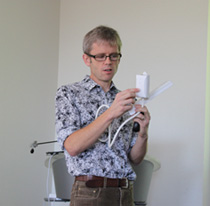Feedback Tools Trip Energy Usage
|
What sets uci@home apart is its emphasis on the social science aspects of energy conservation. Principal investigator David Kirkby, professor of physics and astronomy, used a Fall 2009 sabbatical to launch the project with co-PI Daniel Stokols, a Chancellor's Professor in psychology and social behavior.
Kirkby shared details of the project with a SURF-IT audience during the third installment of the Calit2 summer lunchtime seminar series. Through the SURF-IT program, engineering student Jonathan Chu is working with Kirkby and Stokols on the project to build affordable and effective residential programmable-feedback systems.
“This is not purely an engineering problem,” Kirkby said. “It’s people like you and I that consume energy, [it’s] not the things you plug into the wall. I like to think of that as an opportunity … to make an impact.”
It’s a rather large impact, too. Studies have shown that even minimal feedback to consumers on their energy usage can result in a savings on energy bills of five to 15 percent. If half of the households in the U.S. cut their energy usage by 10 percent, he said, it is equivalent to taking 8 million cars off the road.
|
||||
A fundamental problem for researchers, Kirkby said, is that energy is an invisible, intangible resource. As opposed to a car’s gas tank, which has a meter to inform the driver of the amount of fuel used, an appliance plug looks the same whether it is drawing power or not. That invisibility is “something that humans are not very good at incorporating into our decision-making process,” he noted.
“We are trying to design a system that will trigger behavior changes,” he told the audience. “We want you to reevaluate your old habits.”
Researchers believe the key to success is feedback that encourages energy users to play an active role. “By forcing you to constantly think about your choices, it raises your awareness,” Kirkby said.
A previous study determined four criteria necessary for feedback to affect energy consumption positively: it must be specific, frequent, compelling and motivational.
uci@home researchers are building feedback capability into the connection between the plug and the appliance, instead of into circuit breakers or light switches. The system utilizes custom-made “smart” power strips using electronics and firmware designed by Kirkby. The devices contain a wireless transceiver, temperature and lighting sensors, and multi-colored LEDs and a speaker for immediate audio-visual feedback on appliances, home lighting and heating/cooling usage.
Each device monitors the appliances plugged into it and sends data every three seconds to a central hub. Consumers get real-time feedback on their usage, both by tracking their data through a web interface and by receiving automatic responses in the form of blinking LED lights, chirping sounds and musical interludes.
All of the feedback is configurable remotely, and researchers are reprograming the devices weekly as they seek to optimize their design.
Making the feedback compelling and motivational is a challenge, however. “Energy is measured in kilowatt hours and no one really knows what that is,” Kirkby said. (It’s the equivalent of an 860-kilocalorie cheeseburger and the amount of energy required to run 64 miles). That kilowatt hour only costs about 10 cents; its relative affordability, he added, leaves most people unmotivated by the idea of saving a dollar or two. “You have to rely on other motivations.”
Because the uci@home device presents feedback about electricity, lighting and temperature control, it makes for “a more interesting story. When the feedback is more relevant, you can connect with it better,” Kirkby remarked.
Software adapts the devices to match each consumer’s personal motivation. Users can compare their current usage with last week’s, last month’s or last year’s. Social networking allows comparisons with friends and neighbors. “The high-level software allows you to set your own goals,” said Kirkby. “This also motivates people.”
In addition, the software can play the role of intelligent assistant, giving users prompts based on analysis of their data.
“In order to change consumer behavior, you have to know your consumer,” Kirkby summarized. Engineering is relatively easy … the real challenge in doing this right is to integrate the social science.”
-- Anna Lynn Spitzer



